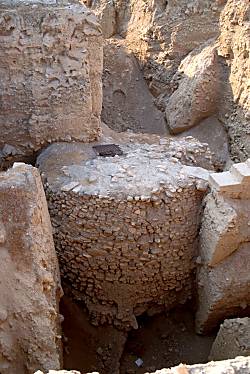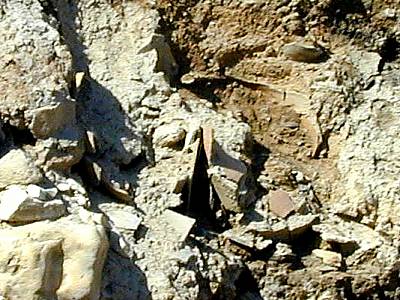
Jericho
After the barrenness of the Desert of Judea, and the funeral waters of the Dead Sea, the lowest spot on the face of the earth, one appreciates what an oasis is. This is the site of the oldest city on earth. On his last journey Jesus passed through here on his way to Jerusalem.

High above
Jericho is a harsh bare mountain, Jebel Quruntul (Mount of the Quarantine or
forty days.) Tradition, attested to by the ancient Greek Monastery that clings
to the side of the mountain, holds that this is the mountain upon which Jesus
was tempted. (Mount of Temptation)
In the valley of this mountain was the winding road from Jericho to
the top of the Mount of Temptation, used by the Levite Priests. They traveled
this road when it was their turn to minister in the Temple. All Levite Priests
lived in Jericho.
Jericho is the oldest town in the world, dating back more than 10,000 years. It lies 260 meters below sea level, making it also the lowest town on earth. Known as the 'City of Palms', Jericho contains some of the world's most important historic sites and is frequently mentioned in the Bible. Jericho's contribution to civilization is unique. The domestication of plants and animals and the invention of pottery took place in ancient Jericho 1000 years before Mesopotamia and Egypt, while the walls and towers of Jericho preceded the pyramids of Egypt by 4000 years. Jericho's moderate climate makes it a favorite winter resort. It is an important agricultural area, producing fresh fruits, and vegetables year round. Jericho dates, bananas and citrus fruits are especially famous..
Jericho was, and is today, a beautiful and lush paradise of food and water.
When Jesus wandered for 40 days at the top of the Mount, he could see Jericho
and all its wonders below. It would be only a few minutes walk to come down to
eat and drink.
Between Jericho and Jerusalem is a road known as the "Valley of the shadow of
death", which can be walked in a day.

Through out much of her history, the ancient town of Jericho has been associated with walls. The most notable story of Jericho is that of Joshua, who according to Biblical accounts caused the circumvallated walls to "come tumbling down." The natural walls surrounding Jericho also are of historical importance to the ancient settlement.
The original walls of Jericho are the result of seismographic activity producing a great rift extending from the Sea of Galilee to Northern Africa. The land in this region dropped some 3,000 feet and settled at least 900 feet below sea level. At this low elevation we find one of the oldest ancient urban dwellings of recorded history, Jericho.
Bounded by Mt. Nebo to the east, the Central Mountains to the west, and the Dead Sea to the south, we find Jericho in the center. Aside from these natural fortifications, Jericho also benefited from natural irrigation afforded by the Jordan River approximately four miles to the west, and from underground tributaries from the Central Mountains which fed her famous oasis. This irrigation resulted in teeming plant life and helped to transform Jericho into a flowing sea of green in an otherwise barren desert.
Jericho's natural resources, beauty, and natural defenses caused her to become the ideal locale for trade. These attributes also made her the source of envy and a coveted possession for invaders of ancient Palestine. Given that Jericho is located in roughly central Palestine, access to her neighboring city-states was a major key to Jericho's importance to invaders and to traders alike. Jericho's location was ideal for the establishing of trade routes and for communication exchange.
The first remains of the town are at tel es-Sultan. The "tel" is a small hill
that is the result of many habitation layers on top of each other. This was the
time before bulldozers and people apparently found it too much trouble to remove
the older ruins, so they just built a new house on top of an old one. The old
houses would become useless after a while due to the rain. Although rain is
extremely scarce in Jericho, the mud-brick houses would collapse and turn into
mud. Layers of mud can clearly be seen in the excavated areas of the tel. Also
destruction occurred because of fires. These account for the black areas that
are seen in the layers.

In the middle of the tel is an open area in which a huge round stone tower lies. Its age is estimated at thousands of years, belonging to the first settlement in Jericho. In the middle of the tower is a perfectly preserved stairway. The stones of this building are not made from mud, but from natural stones. It is this tower which gives Jericho its status as oldest city on earth, because nowhere else a tower or similar building has been found from such an old age.
From the last occupation until around 1000 years before Joshua, there are parts of a city wall and rampart on the southern side of the tel. At the beginning of the 20th Century, when this wall was first dug out, archaeologists wanted to believe that these were the walls that Joshua conquered. But it was later proved that they are 1000 years older. Now it is thought that there are no remains at the tel of Jericho from the time the Israelites arrived in the Promised Land. About this the debate still goes on.
At a later period, the area of Jericho was given to Herod by the Roman
Emperor Octavian as a reward for his assistance during the war. Before that the
Judean king leased the oasis and its plantations from Queen Cleopatra of Egypt.
Herod had a winter resort at the entrance to the wadi. Once he acquired the
city, he built new aqueducts to irrigate the area and a new winter palace on the
place of the old Hasmonean winter residence on the same location. The ruins of
these luxurious palaces are worth a separate visit.
Since the Byzantine era monks, or rather hermits flocked the Holy Land. They did
not always reside in monasteries, but inhabited the pervasive natural caves in
the surrounding mountains of the Judean desert. These caves were also used by
Jewish refugees or rebels from ancient times, for instance by Bar Kochba. The
monastery in Jericho, a literal cliffhanger against the Mount of Temptation, is
actually half built in such a cave. The cave-church is from medieval times. In
the 19th Century, the Greek Orthodox bought the place and built the monastery.
The place is open to everyone, modest dress required. The cloister can be
reached by the cable car or climbing for about 30 minutes.
Holy Land Greece Pilgrimages Pilgrimages Map Index Espaņol English Index